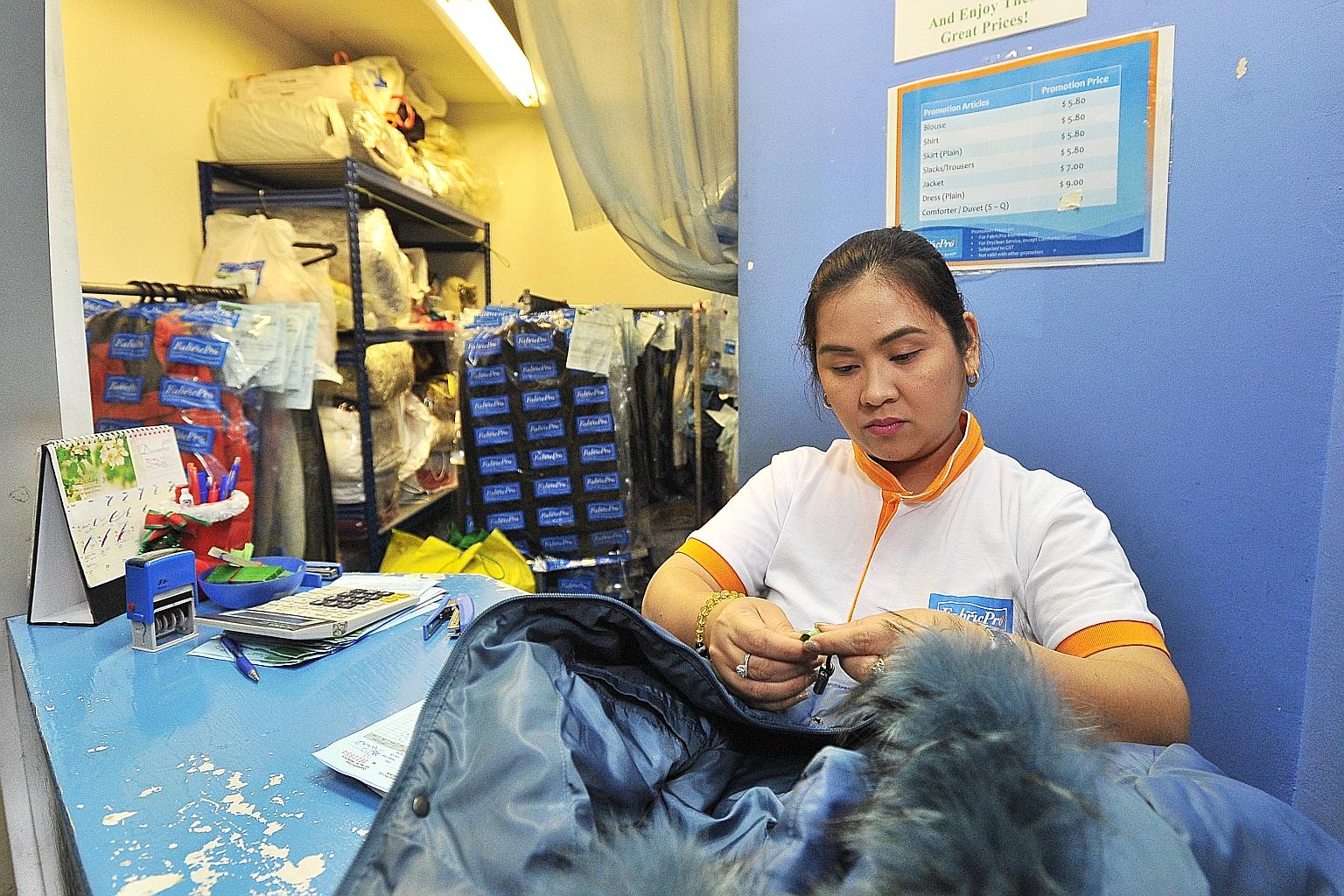Laundries urged to clean up their act
Case says the industry needs a standard set of guidelines to protect customers' interests
Sign up now: Get ST's newsletters delivered to your inbox

FabricPro Dryclean and Laundry Services was the only one out of the 30 laundries surveyed that had standard terms and conditions which its staff explained to customers and asked them to sign.
PHOTO: LIM YAOHUI FOR THE STRAITS TIMES
Jessica Lim
Follow topic:
Shredded curtains, burn marks on garments and misplaced items are among the woes faced by laundry customers.
After receiving 71 complaints since 2012 - mostly about laundries refusing to pay the requested compensation - the Consumers Association of Singapore (Case) is taking a closer look at the industry.
One customer sent his wine-stained $900 jacket for dry-cleaning, only to find a burn mark on it when it was returned. The firm claimed it was caused by a chemical reaction with the red wine and denied liability. After Case intervened, a $100 refund was offered.
In another case, six of 14 saris sent to a dry-cleaner came back torn and with iron burns. The business admitted that staff had caused the damage, but refused to compensate the customer in cash. Instead, it offered her second-hand saris which other customers had not collected.
Case sent mystery shoppers to 30 laundries in July and found that although 29 had some form of liability coverage, 27 did not explain terms and conditions clearly to customers, resulting in confusion.
-
WHAT TO WATCH OUT FOR
To ensure that you are not being hung out to dry when you visit a laundry, here are some tips from the Consumers Association of Singapore:
• Always ensure that there is a proper refund policy for lost or damaged articles before signing on the dotted line.
• Take note of the small print on the sales invoice or receipt specifying the terms and conditions of the laundry service, with special attention paid to the clauses concerning damaged or lost articles. Many laundries have a cap on liability coverage.
• Check returned articles thoroughly upon collection and alert the business to any issues promptly. Some laundries may state that liability claims must be made within 24 hours of the collection of the article.
• Always keep all original receipts and invoices.
• Pay attention to the care labels on the garment and highlight the cleaning instructions to the vendor. If unsure, consumers should ask the vendor for advice on the suitability of the material to be washed or dry-cleaned.
Jessica Lim
Only seven shops asked for a signature from customers to acknowledge the terms and conditions, and 10 did not indicate any cap on their liability coverage. The coverage also differed widely between outlets - with 21 offering coverage for both lost and damaged articles, five covering only lost items and three that did not state either way. One, Choon Kee Laundry in Jalan Kukoh, did not have standard terms and conditions or even a price list.
Case's president, Mr Lim Biow Chuan, said: "Based on the survey results, Case believes that there is a need for the adoption of a standard set of guidelines on industry practices for the laundry industry and plans to look further into the matter."
Mr Cheong Sing Mun, 60, owner of Choon Kee Laundry, said: "We are a small company. Our customers are regulars so we haven't run into problems. We've never had any standard practices. Our customers already know the prices, and anyway we can just tell them."
In Yishun's Northpoint mall, FabricPro Dryclean and Laundry Services was the only firm out of those surveyed that had standard terms and conditions which staff explained to customers and asked them to sign. It also had a clear liability cap and covered both lost and damaged items.
Its co-founder, Ms Sarah Goh, 47, said the 10-outlet chain did not start off that way. It has been tweaking its operations continually since it opened its first outlet in 1994. In the early years, it would get four to five customer claims a year that went all the way to the Small Claims Tribunals. After tweaking its practices, it now gets only one or two a year.
"We had many discussions about how to improve," she said. "Being clear also helps us to safeguard ourselves and keep customers informed so they can decide whether they want to take the risk or not."
Particularly tricky items include curtains that have been exposed to the sun, which weakens the fabric; poor-quality zippers; and bad dye jobs by clothing manufacturers, she said. She added: "It can be tough for laundry businesses to predict damages or how severe they will be."
Lawyers told The Straits Times that terms and conditions are legally binding in a court of law only if the customer has been informed of them in advance.
Madam Tracey Yeo, 39, sent a pair of Coach brand shoes for dry-cleaning earlier this year, but discovered brown stains on them upon collection. The sales manager asked to be compensated $100 for the $450 pair of shoes but has yet to receive a cent.
"They refused and wanted me to get a report from the brand to show that the shoes were damaged," she said, adding that the shop did not explain any terms and conditions to her. "I felt that I just couldn't trust the business any more."

